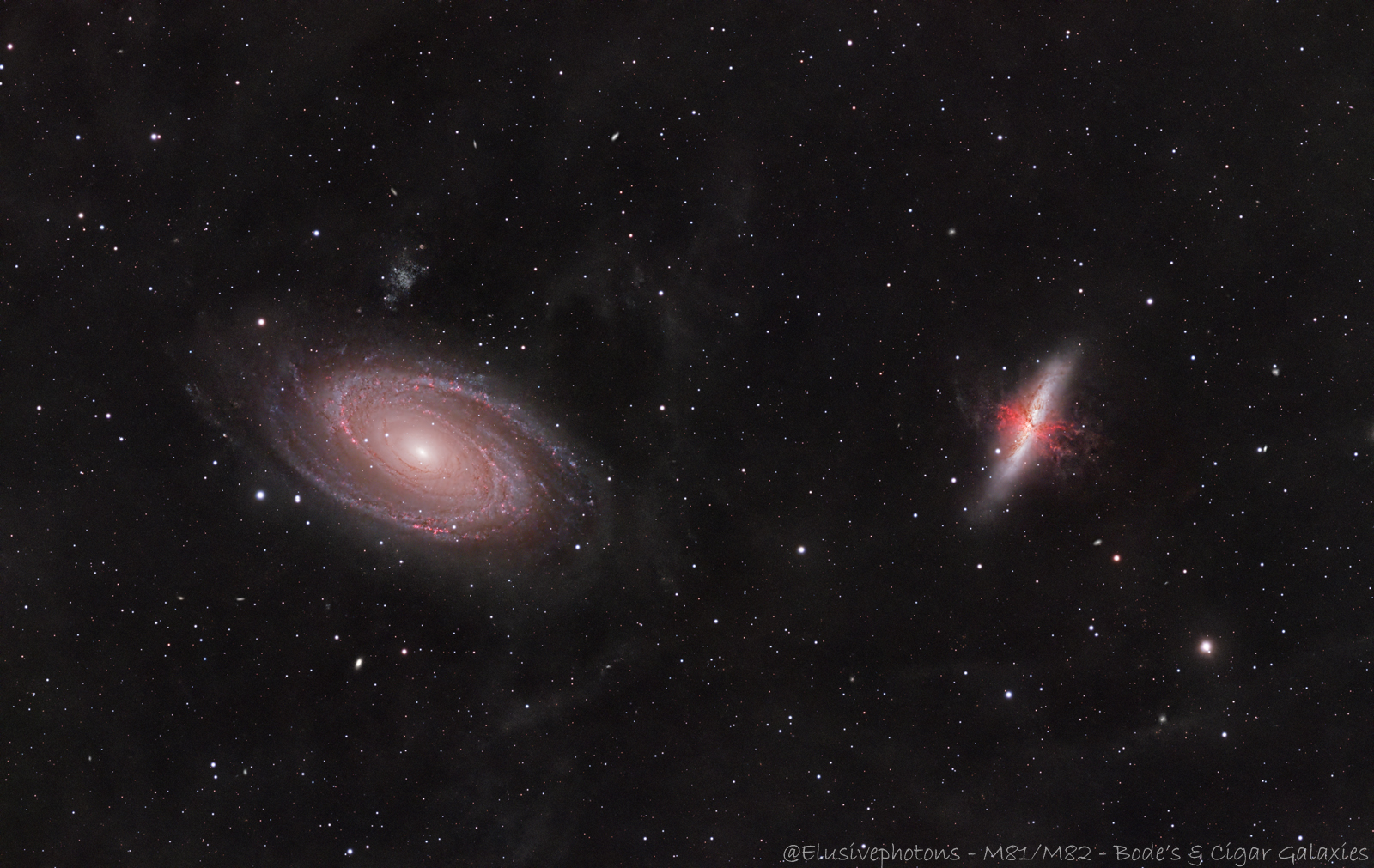Date:
February 17-20th - 2024
March 16-17th, 29-31st - 2024
•
Exposure:
229 x 5 minutes (L-Quad)
161 x 5 minutes (PO)
Total: 32hr 30min
About This Image
Gear:
Telescope: Stellarvue SVX130T-R
Mount: Software Bisque Paramount MX
Camera: Player One Poseidon-C Pro
Filter: Optolong L-Quad Enhance, Player One Anti-Halo Dual-Band Ha+OIII 2"
Accessories: 3.5" Feathertouch • Stellarvue SFFX2
Guiding: Starfield 50mm Guide Scope • Player One Neptune 664C • PHD2
Software: Photoshop • PixInsight • TheSkyX • Starkeeper Voyager • GraXpert
Description:
The M81 and M82 galaxy group, located in the constellation Ursa Major, is a captivating assembly of galaxies approximately 12 million light-years away from Earth. This group is dominated by two principal galaxies: M81, also known as Bode's Galaxy, and M82, commonly referred to as the Cigar Galaxy. M81 is a grand design spiral galaxy, boasting a diameter of about 90,000 light-years, which is roughly 70% the size of the Milky Way. It is enveloped by a halo of stars and globular clusters, contributing to its striking appearance. The galaxy is also a source of strong radio waves, indicative of intense magnetic fields within. M81's supermassive black hole, with a mass estimated to be around 70 million times that of our sun, is a subject of significant scientific interest. The galaxy's spiral arms and intricate structure have made it a favorite target for both professional and amateur astronomers, providing insights into the formation and evolution of spiral galaxies[2][4].
M82, on the other hand, presents a stark contrast to its companion M81 with its irregular shape and intense starburst activity. This activity is concentrated in the galaxy's central region, which is surrounded by a thick ring of dust and gas. M82 is home to numerous bright star clusters and supernova remnants, and it also harbors a supermassive black hole at its center, estimated to be about 100 million times the mass of the Sun. The gravitational interaction with M81 has distorted M82's shape and triggered the starburst activity, leading to its classification as a starburst galaxy. This interaction has also resulted in the formation of tidal dwarf galaxies, compact star-forming objects created from tidal debris[1][3][4].
The interaction between M81 and M82 is a fascinating example of galactic dynamics. The tidal forces exerted by M81 have caused M82’s gas and dust to be pulled out of its disk, resulting in an elongated and irregular appearance. This has also led to the intense star formation in M82, making it one of the brightest infrared galaxies in the sky. The study of these interactions provides valuable insights into the evolution of galaxies in cluster environments. Both M81 and M82 have been extensively studied, with observations from telescopes such as Hubble revealing detailed structures like the shredded clouds and flame-like plumes of glowing hydrogen in M82, and the tightly wound spiral arms of M81[4][5][6].
Sources:
[1] visibledark.ca/ the-magnificent-galaxy-m82-in-ursa-major-constellation/
[2] facts.net/nature/universe/ 13-extraordinary-facts-about-bodes-galaxy-m81/
[3] en.wikipedia.org/wiki/Messier_82
[4] stargazerwny.org/bodes-galaxy-m81-and-the-cigar-galaxy-m82/
[5] constellation-guide.com/messier-82-cigar-galaxy/
[6] esa.int/Science_Exploration/Space_Science/ Hubble_s_view_of_Cigar_Galaxy_on_sixteenth_mission_anniversary
Distance: 12 million light-years
Size: M81: 90,000 light-years, M82: 40,000 light-years
|



